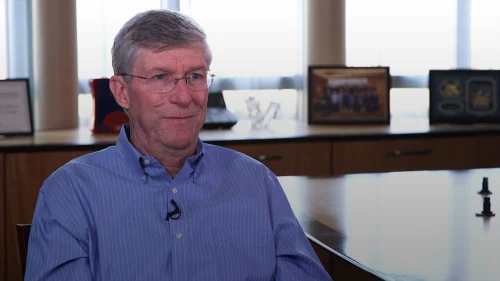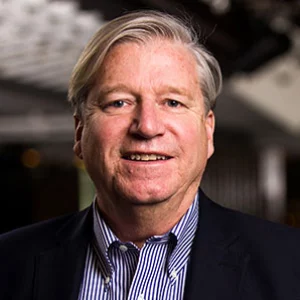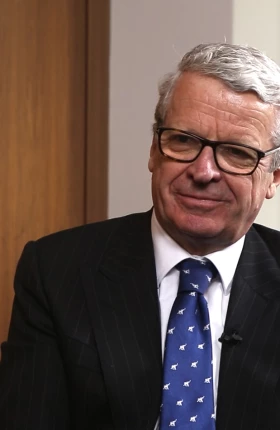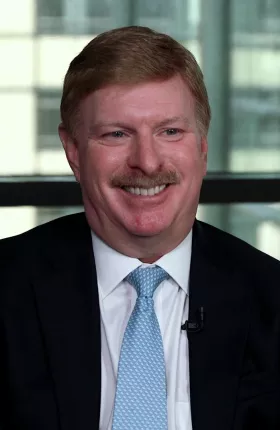Vincent Forlenza, CEO of BD, knew that his global medical technology company was thriving—but he also knew that the health care industry was changing quickly. Hospitals and physician practices were struggling to manage costs, and many were consolidating and limiting the number of suppliers they used. BD couldn't afford to rest on its laurels.
In addition to completing two major acquisitions—of CareFusion for $12.2 billion in 2014 and of C. R. Bard, Inc. for $24 billion in 2017—BD has launched a full-scale transformation. At the beginning of this transformation, the company took stock of everything, asking questions such as “What's working? What isn’t? Do we have the right people and the right capabilities in place?”
With the transformation now well underway, Forlenza says that it has been essential to create a purpose-driven culture, encourage open and constructive dialogue, and stay intensely focused on the ways BD's products improve patient outcomes and save lives.
Forlenza recently sat down with Grant Freeland, a BCG senior partner, managing director, and global leader for the firm’s People & Organization practice. Edited excerpts from their conversation follow.
About Vincent A. Forlenza
About Vincent A. Forlenza
At a Glance
Born in: East Orange, NJ
Year born: 1954
Education
1975, BS, Lehigh University
1980, MBA, Wharton School, University of Pennsylvania
Career Highlights
2011–present, BD, president and CEO
2009–2011, BD, president and chief operating officer
2003–2009, BD, president of biosciences division
1998–2003, BD, senior vice president for technology, strategy, and development
1996–1998, BD, president of microbiology systems
1980–1996, BD, held various positions in several business units focused on strategic planning, business development, and general management
Thank you very much for joining us today. When you took the role of CEO in 2011, you had three priorities: innovation, operational performance and efficiency, and culture. Why those three things?
We spent time as an organization looking at the company strategy. What was working? What was not working? If we were going to be successful with our strategy, we had to take the innovation system to a new level. We heard that loud and clear from the organization. We knew it ourselves. That was the number one focus.
Number two, we couldn't fund the things that we wanted to do without the operational efficiency piece.
Third, we had to have the people, the capability, and the culture to do some new and different things. Culture was a very important part of this. Strategy was changing. We had to change the culture to make that happen, and we were becoming more and more global. You had to make all of this work.
Tell us about how you got the right talent. How did you build the capabilities?
Change started at the top with my team. I'm going to say it was about a third, a third, a third. There was a third that stayed in the same roles and were excited about the new strategy and worked to develop that strategy. There was another third where we had great people that we promoted into roles. And then there was about a third that came from outside. They tended to be where we were adding a brand new capability that we didn't have within the company.
When we started to broaden our strategic thinking, moving into adjacent areas and creating solutions, we had to develop a whole set of strategic tools to understand the customer. We went outside the company to do that because we really didn't have the capability inside.
You now have this new senior team, new people, and new roles, some coming from the outside. How did you get them aligned around where you were heading?
When I took over, we had a leadership team that reported to the CEO, and everything went there. As we expanded the agenda for the company, it was obvious to me that this was not going to be sufficient. While I maintained my own leadership team, we started to create subgroups of that leadership team that took responsibility for various aspects of the strategy—but they always kept coming together back at the top as a group.
We did all sorts of things. I wrote whitepapers, for example, on what this should look like. Then we got together and we hashed it out, we changed it, we evolved it. One change we had to make was that maybe people were too nice. We weren't having all the conversations we wanted to have, so we started something called constructive challenge. Constructive challenge helps make sure that we're getting the issues on the table—not just internally, but if we come up with an idea for a new product, are we talking to the people who love the idea, and it's the two people in the world who love that idea? Or are we going out and finding the naysayers and hearing them and bringing those ideas in.
We started down that pathway and started educating ourselves, asking, “How do we do this?” I think that changed a lot within the company, in terms of the culture. That's something we continued to work on. If we get an issue on the table, we solve it.
In the last couple years you've done some deals, including with CareFusion and C. R. Bard. Why did you feel you had to do those acquisitions, versus organic growth?
We were being successful with our organic strategy. We increased revenue from about 3% per year up to about 5%. But when you looked at what was happening within the industry, the strategy called for being a true strategic partner. That meant that we were going to have to broaden our capabilities to create complete solutions for a certain percentage of the marketplace—what I call “value added-anchor products.” The issue was that, as we looked at these solutions, we could not do it all ourselves. If we were really going to create a solution, it was going to require much larger acquisition. Also, you could see the industry consolidating—and if we didn't act on these acquisitions, the opportunities were going to be gone.
How do you make an acquisition successful?
You start with the purpose—uniting people around the purpose—and getting people highly motivated and excited about coming together. For us, that's around what can we do for a patient anywhere on the globe. If we can get people excited about that and feeling that they can make a difference, as an individual and as a company, a lot of problems go away very, very quickly.
We also made the customer and the patient very real for people. We bring them into our town halls, we walk through situations where patients had an operation or a procedure, and our products were used, and it saved someone's life. People could see that when you put the pieces together, it was much more impactful and had a much more positive outcome on the patient.
If I were a new CEO, about to embark on a major transformation, what advice would you give me?
I'd start with the top team. Are they aligned with the transformation or not? Do you have the talent and capabilities that you need to undertake this transformation? You really have to start there, and you have to think through the sequencing of what you want to do.
Second, it's incredibly important to get this purpose-driven culture not just into your leadership team but into the middle of the organization, so they understand what you're trying to do and why you're trying to do it, and to get the buy-in.
Third, do you have the right governance in place, so that you can move forward with the transformation? Once you have the right governance in place, you can have the right metrics to ensure that you're making progress.
Lastly, you have to have a big-time change management program to make sure that you're bringing the organization along. And you're going to have to resource that.







